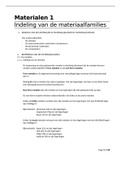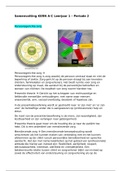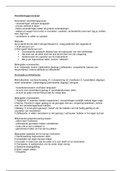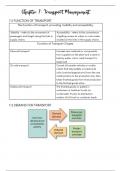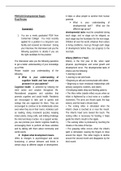PSYCHOLOGY 253
These notes were assembled by Michaela Goncalves. They include notes from the
prescribed textbook The Essentials of Statistics for the Behavioural Sciences 9th Edition
by Frederick J. Gravetter as well as the lectures presented by Dr Roomaney and Dr Rabie
Basically, I own none of this :D
1 of 79
, Notes by: Michaela Goncalves
22587934
Psych 253
Data Analysis
Any calculations will be written in green (formula page at the end)
Any important info will be in red
Definitions will be in blue (list of all by chapter included at the end)
Examples will be in pink
Questions from the textbook are also included at the end plus answers
PLEASE NOTE: These notes do not serve as an alternative to the podcasts. Podcasts are fundamental to your
understanding of the work
Also please don’t send these to anyone who hasn’t paid. I worked really hard to make these as in depth and easy to
understand as possible :)
Important dates and info:
Exam:
Exam is on the 13th November at 9am and second opportunity exam is on the 5th of December at 2pm.
The exam is 100 marks (120 minutes) and complied of Multiple Choice questions as well as theory
questions and calculations.
The final mark is calculated from your class mark (40%) and your exam mark (60%). Therefore to work out
your final mark: (Class Mark x 0.4) + (Exam Mark x 0.6)
PRE NOTE TO ALWAYS REMEMBER
Hey diddle diddle,
The median’s the middle,
You add and divide for the mean,
The mode is the one that appears the most
And the range is the difference between
CHAPTER 1: INTRODUCTION TO STATISTICS
Lecture 1.1
Chapter 1: Scales of Analysis
• Statistics consists of facts and figures
• Statistics are informative and time saving because they condense large quantities of information into
a few simple figures
• They refer to a general field of mathematics
• It is a shortened version of statistical procedures and involves gathering information
• These statistical procedures help ensure that the information or observations are presented and
interpreted in an accurate and informative way
• They are used to organise and summarise the information so the researcher can see what happened
in the research study and is therefore able to communicate these results to others
• These help the researcher to answer questions that initiated the research by determining what
general conclusions are justified based on the findings
2 of 79
, Notes by: Michaela Goncalves
22587934
• The term statistics refers to a set of mathematical procedures for
organising, summarising and interpreting information
• They provide researchers with a set of standardised techniques that are recognised and understood
throughout the scientific community
• Populations and samples
• A population is the set of all the individuals of interest in a particular study
• Populations can vary in size from extremely large to very small
• An example would be “women” or “men”
• This should always be identified by the researcher and it doesn’t have to specifically refer to
people (rats, birds etc.)
• A set of individuals selected from a population and intended to represent the population is called a
sample
• A sample should always be identified in terms of the population from which it was selected
• Can also vary in size but is usually smaller than a population
• When a researcher finishes examining the sample, the goal is then to generalise the results back
to the entire population
• Variables and Data
• A variable is a characteristic or condition that changes or has different values for different individuals
• Variables can also be environmental conditions like time of day, temperature etc.
• The measurement obtained for each individual is called a datum (or score or raw score). This is a
single measurement or observation which is commonly called a score or raw score
• The complete set of scores is called the data set or simple the data. Data is the measurements or
observations. A data set is the collection of measurements or observations
• Note that every sample or population of individuals produces a corresponding sample or population
of scores.
• Parameters and Statistics
• You should always specify whether the data came from a population or a sample
• A parameter is a value (usually a numerical value) that describes a population and is derived from
measurements of the individuals in a population
• A statistic is a value (usually a numerical value) that describes a sample and is derived from
measurements of the individuals in the sample
• Every population parameter has a sample statistic
• Descriptive and Inferential Statistical Methods
• Descriptive statistics
• Descriptive statistics are statistical procedures that are used to summarise, organise and simplify
data
• They are techniques that take raw scores and organise or summarise them in a form that is more
manageable
• Scores are organised in a table or graph
• A commen technique is to summarise a set of scores by producing an average
• Used to simply pages and pages of data
3 of 79
, Notes by: Michaela Goncalves
22587934
• Provide a simplified, organised description of the scores (they describe)
• Once the researcher has described the scores they need to then interpret the results (this is
where inferential stats is used)
• Inferential statistics
• Inferential statistics consist of techniques that allow us to study samples and then make
generalisations about the populations from which they were selected
• Some researchers use this to draw conclusions about population parameters
• However a sample only provides limited information about a population and therefore it is not
expected to give a perfectly accurate picture of the whole population
• There is some discrepancy between a sample statistic and the corresponding population
parameter
• Sampling error
• A sampling error is the natural occurring discrepancy or error that exists between a sample statistic
and the corresponding population parameter
• Very unlikely that the statistics obtained for a sample will be identical to the parameters for the entire
population
• The scores that make up the data from a research study are the result of observing and measuring
variables
• Constructs and Operational Definitions
• Variables like intelligence, anxiety and hunger are called constructs
• Also often called hypothetical constructs because they can’t be directly observed
• Constructs are internal attributes or characteristics that cannot be directly observed but are
useful for describing and explaining behaviour
• An operational definition identifies a measurement procedure ( a set of operations) for measuring
an external behaviour and uses resulting measurements as a definition and a measurement for a
hypothetical construct. It has 2 components namely; describes a set of operations for measuring
a construct and defines the construct in terms of the resulting measurements
• Discrete and continuous variables
• A discrete variable consists of separate, indivisible categories and there are no intermediate
values between adjacent categories.
• For example, a quiz containing multiple choice questions
• Restricted to whole, countable numbers and may also consist of observations that differ
qualitatively
• Think of university majors (law, art, humanities etc)
• Continuous variable contain an infinite number of possible values that fall between any two
observed values and is divisible into an infinite number of fractional parts
• Time, weight, height.
• If it seems like it can go onto a line (like coronavirus graphs) then it is a continuous variable
• Two other factors apply to continuous variables
• When measuring a continuous variable, it should be very rare to obtain identical
measurements for two different individuals due to the fact that it has an infinite number of
possible values
4 of 79
These notes were assembled by Michaela Goncalves. They include notes from the
prescribed textbook The Essentials of Statistics for the Behavioural Sciences 9th Edition
by Frederick J. Gravetter as well as the lectures presented by Dr Roomaney and Dr Rabie
Basically, I own none of this :D
1 of 79
, Notes by: Michaela Goncalves
22587934
Psych 253
Data Analysis
Any calculations will be written in green (formula page at the end)
Any important info will be in red
Definitions will be in blue (list of all by chapter included at the end)
Examples will be in pink
Questions from the textbook are also included at the end plus answers
PLEASE NOTE: These notes do not serve as an alternative to the podcasts. Podcasts are fundamental to your
understanding of the work
Also please don’t send these to anyone who hasn’t paid. I worked really hard to make these as in depth and easy to
understand as possible :)
Important dates and info:
Exam:
Exam is on the 13th November at 9am and second opportunity exam is on the 5th of December at 2pm.
The exam is 100 marks (120 minutes) and complied of Multiple Choice questions as well as theory
questions and calculations.
The final mark is calculated from your class mark (40%) and your exam mark (60%). Therefore to work out
your final mark: (Class Mark x 0.4) + (Exam Mark x 0.6)
PRE NOTE TO ALWAYS REMEMBER
Hey diddle diddle,
The median’s the middle,
You add and divide for the mean,
The mode is the one that appears the most
And the range is the difference between
CHAPTER 1: INTRODUCTION TO STATISTICS
Lecture 1.1
Chapter 1: Scales of Analysis
• Statistics consists of facts and figures
• Statistics are informative and time saving because they condense large quantities of information into
a few simple figures
• They refer to a general field of mathematics
• It is a shortened version of statistical procedures and involves gathering information
• These statistical procedures help ensure that the information or observations are presented and
interpreted in an accurate and informative way
• They are used to organise and summarise the information so the researcher can see what happened
in the research study and is therefore able to communicate these results to others
• These help the researcher to answer questions that initiated the research by determining what
general conclusions are justified based on the findings
2 of 79
, Notes by: Michaela Goncalves
22587934
• The term statistics refers to a set of mathematical procedures for
organising, summarising and interpreting information
• They provide researchers with a set of standardised techniques that are recognised and understood
throughout the scientific community
• Populations and samples
• A population is the set of all the individuals of interest in a particular study
• Populations can vary in size from extremely large to very small
• An example would be “women” or “men”
• This should always be identified by the researcher and it doesn’t have to specifically refer to
people (rats, birds etc.)
• A set of individuals selected from a population and intended to represent the population is called a
sample
• A sample should always be identified in terms of the population from which it was selected
• Can also vary in size but is usually smaller than a population
• When a researcher finishes examining the sample, the goal is then to generalise the results back
to the entire population
• Variables and Data
• A variable is a characteristic or condition that changes or has different values for different individuals
• Variables can also be environmental conditions like time of day, temperature etc.
• The measurement obtained for each individual is called a datum (or score or raw score). This is a
single measurement or observation which is commonly called a score or raw score
• The complete set of scores is called the data set or simple the data. Data is the measurements or
observations. A data set is the collection of measurements or observations
• Note that every sample or population of individuals produces a corresponding sample or population
of scores.
• Parameters and Statistics
• You should always specify whether the data came from a population or a sample
• A parameter is a value (usually a numerical value) that describes a population and is derived from
measurements of the individuals in a population
• A statistic is a value (usually a numerical value) that describes a sample and is derived from
measurements of the individuals in the sample
• Every population parameter has a sample statistic
• Descriptive and Inferential Statistical Methods
• Descriptive statistics
• Descriptive statistics are statistical procedures that are used to summarise, organise and simplify
data
• They are techniques that take raw scores and organise or summarise them in a form that is more
manageable
• Scores are organised in a table or graph
• A commen technique is to summarise a set of scores by producing an average
• Used to simply pages and pages of data
3 of 79
, Notes by: Michaela Goncalves
22587934
• Provide a simplified, organised description of the scores (they describe)
• Once the researcher has described the scores they need to then interpret the results (this is
where inferential stats is used)
• Inferential statistics
• Inferential statistics consist of techniques that allow us to study samples and then make
generalisations about the populations from which they were selected
• Some researchers use this to draw conclusions about population parameters
• However a sample only provides limited information about a population and therefore it is not
expected to give a perfectly accurate picture of the whole population
• There is some discrepancy between a sample statistic and the corresponding population
parameter
• Sampling error
• A sampling error is the natural occurring discrepancy or error that exists between a sample statistic
and the corresponding population parameter
• Very unlikely that the statistics obtained for a sample will be identical to the parameters for the entire
population
• The scores that make up the data from a research study are the result of observing and measuring
variables
• Constructs and Operational Definitions
• Variables like intelligence, anxiety and hunger are called constructs
• Also often called hypothetical constructs because they can’t be directly observed
• Constructs are internal attributes or characteristics that cannot be directly observed but are
useful for describing and explaining behaviour
• An operational definition identifies a measurement procedure ( a set of operations) for measuring
an external behaviour and uses resulting measurements as a definition and a measurement for a
hypothetical construct. It has 2 components namely; describes a set of operations for measuring
a construct and defines the construct in terms of the resulting measurements
• Discrete and continuous variables
• A discrete variable consists of separate, indivisible categories and there are no intermediate
values between adjacent categories.
• For example, a quiz containing multiple choice questions
• Restricted to whole, countable numbers and may also consist of observations that differ
qualitatively
• Think of university majors (law, art, humanities etc)
• Continuous variable contain an infinite number of possible values that fall between any two
observed values and is divisible into an infinite number of fractional parts
• Time, weight, height.
• If it seems like it can go onto a line (like coronavirus graphs) then it is a continuous variable
• Two other factors apply to continuous variables
• When measuring a continuous variable, it should be very rare to obtain identical
measurements for two different individuals due to the fact that it has an infinite number of
possible values
4 of 79


